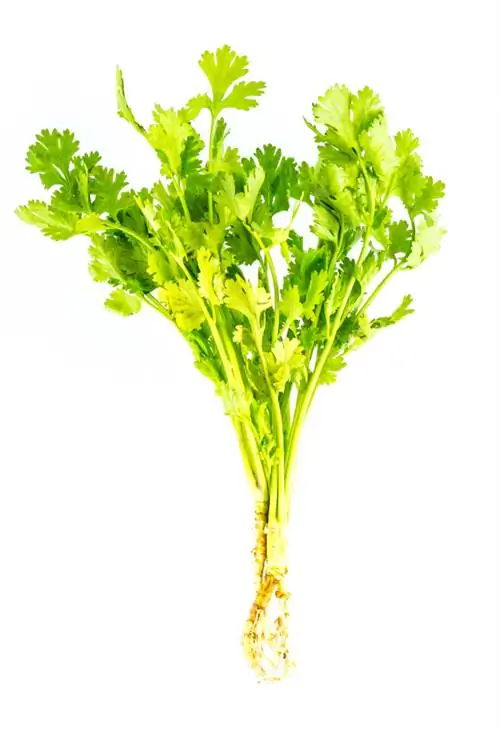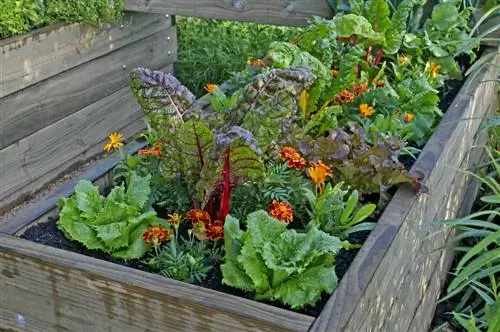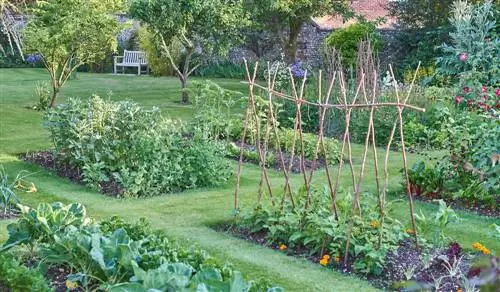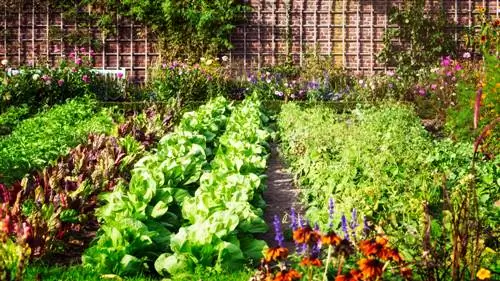- Author admin [email protected].
- Public 2023-12-29 04:51.
- Last modified 2025-01-23 11:22.
It's not just in agriculture that gardeners have to pay attention to the correct crop rotation, it's also worth creating a plan for the vegetable garden in hobby gardening. Because those who grow correctly harvest more and have to struggle less with diseases, pests and weeds. Below we will explain to you what crop rotation is all about, give you examples of good crop rotations, tables with the most important vegetables as well as helpful information and tips.
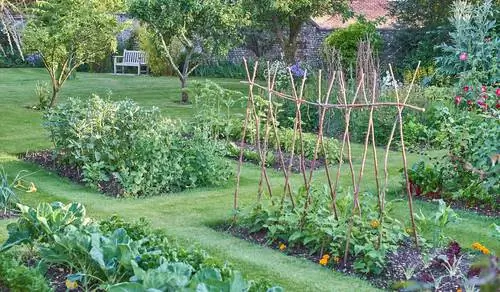
What is crop rotation in horticulture?
Crop rotation is a farming method in which different crops are grown one after the other over the course of several years to improve soil quality and crop yields. It is based on the rotation of heavy, medium and weak feeders as well as green manure plants.
What is crop rotation?
Crop rotation, also known as field farming, refers to the temporal sequence of growing different types of crops over several years.
The basic idea of crop rotation is that different types of vegetables and grains require different nutrients and, above all, to different degrees. If the same vegetables are grown in the same place for years, they always extract the same nutrients from the soil. This means that the soil becomes impoverished and the plant can no longer receive sufficient nutrition. This leads to lower crop yields, susceptibility to diseases and pests and poor soil quality. However, if you grow different plants with different nutrient needs on a bed every year, you can counteract this.
Why pay attention to the correct crop rotation?
Crop rotation has a positive effect on crop yield, but that's not all. Good crop rotation has even more advantages:
- prevents pests and diseases
- reduces weed growth
- increases soil fertility
- Rooting and thereby loosening the soil
- Leguminoses enrich the soil with nitrogen
- Promotion of soil-supporting microorganisms
- Control of nematodes
- it reduces the use of expensive fertilizers
- Prevention of erosion and leaching of nutrients
Background
The history of crop rotation
Crop rotation is as old as humanity's cultivation of grain. When people settled down and began to grow grain, it quickly became apparent that yields decreased significantly after several years of cultivation. They then first developed the two-crop economy, in which cereals and leafy vegetables and/or legumes were grown alternately. In the Middle Ages, the three-field economy became established, in which initially only grain, leafy vegetables and green manure were grown. In the 18th century, turnips and potatoes were added.
Heavy feeders, weak feeders and green manures
The decisive factor for correct crop rotation is the nutrient requirements of the plants. A distinction is made between heavy eaters, medium eaters and weak eaters.
- Weak eaters: Such plants, mostly leafy fruits, that require few nutrients such as lettuces, spinach or herbs or those that provide themselves with nutrients such as legumes such as beans or peas
- Medium feeders: Plants with a medium nutrient requirement such as beets, onions or leeks
- Heavy feeders: Plants with a high nutrient requirement such as potatoes, tomatoes, pumpkin or cabbage
Green manure
In order to enrich the soil with nutrients again after a cultivation cycle of several years, green manure is grown. Legumes that enrich the soil with nitrogen are particularly suitable for this, such as:
- Clover
- Phacelia
- Peach
- Lupins
- Marigold
- oil radish
These fruits are not harvested, but rather mulched and incorporated into the soil, where they rot and enrich the soil with additional nutrients.
2 to 5 year cycles for crop rotation
Depending on the model, the crop rotation is divided into 2, 3, 4 or 5 years. In agriculture, shorter cycles are often used to avoid losses in the main crop. In the vegetable garden, on the other hand, three- or four-field farming is often favored, which means that heavy feeders are only planted in one bed every three to four years.
Crop rotation in the 4-year cycle
In the 4-year cycle, heavy feeders are grown on a fresh, nutrient-rich bed in the first year, medium feeders in the second, weak feeders in the third and green manure in the fourth. This method is most common in private vegetable gardens.
Table for crop rotation in the 4-year cycle
| 1. Year (heavy eater) | 2. Year (medium consumption) | 3. Year (weak eater) | 4. Year (green manure) |
|---|---|---|---|
| Potatoes | Fennel | Bush beans | Buckwheat |
| cabbage | Beets of all kinds | Peas | Clover |
| Cucumbers | Salads | Herbs | Phacelia |
| Pumpkin | Strawberries | Lettuce | Marigolds |
| Rhubarb | garlic | Spinach | Spinach |
| Celery | Leek | Summer flowers | Peach |
| Tomatoes | pole beans | Lamb lettuce | Lupine |
| Savoy cabbage | Onions | oil radish | |
| Corn | Tagetes |

Excursus
Mixed culture and crop rotation
In addition to crop rotation, when planning your vegetable garden you should also pay attention to the compatibility of the plants with each other. Although both potatoes and tomatoes are heavy feeders and are therefore grown in the same year, they do not get along particularly well and should not be planted in the same bed. The same goes for potatoes and pumpkin. Other plants have a positive effect on each other, such as tomatoes and nasturtiums, where nasturtiums protect the tomatoes from aphids. You can find out more about mixed culture here.
The crop rotation in the bed cycle
Now you might want to grow potatoes and tomatoes every year. This is of course possible as long as you don't plant them in the same location. A simple model is the bed cycle, also known as square gardening. Four beds are cultivated at the same time, one with weak feeders, one with medium feeders, one with heavy feeders and one with green manure. Every year the bed sequence is shifted by one bed, so that foundations are grown on the weak-zehrer bed, weak-zehrer on the medium-zehrer, medium-zehrer on the strong-zehrer and strong-zehrer on the green manure, etc. Here you will find the whole thing clearly illustrated.
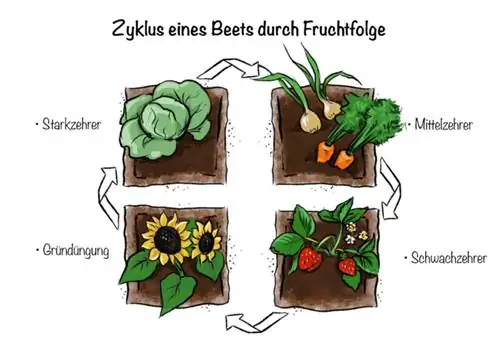
Make a cultivation plan
Even if the concept sounds simple, logical and clear, it is recommended to create a plan so that you know exactly where you have planted what. This concept works best if you have three, four or five beds and rotate them as described in the bed cycle above. To plan the cultivation in detail, proceed as follows:
- Measure your beds and make sketches of them on one or more sheets.
- Divide the bed into the appropriate rows that you want to grow. Pay attention to the recommended row spacing.
- Now enter in each row what should be grown there. Pay attention to good and bad neighbors.
- You can also note sowing and harvest times as well as any second sowing.
- Next year, simply move the sowing one bed to the right so that the crop rotation is in place. If necessary, correct poorly chosen neighbors that resulted in low crop yields.
Those who combine cleverly have less work.
Crop rotation in agriculture
Crop rotation also plays a major role in agriculture, not just organic farming. Not only is the main crop changed regularly, but different things are also grown within the same year. A distinction is made here between summer fruit, winter fruit and catch crop.
- Summer Fruit: This is a crop that is sown in spring and harvested in summer. This can be summer grains as well as beets, potatoes or vegetables.
- Winter Fruit: Winter fruits are crops that are frost hardy and therefore spend the winter in the field. This can be winter grains or winter vegetables.
- Cover crop: The cover crop is usually legumes that are grown between the main crops to improve the soil.
Excursus
Cover crop
A wheat producer cannot wait three years until he can grow wheat again in his field. That's why the cultivation cycles in agriculture are shortened: instead of growing a catch crop in the third or fourth year, a catch crop is sown after the main crop. The EU specifies guidelines according to which monocultures are not grown as catch crops, but rather various soil-supporting plants such as clover, peas, mustard, oil radish or field grass. These can be used to feed livestock or then worked into the ground.
Frequently asked questions
Are there also “perennial fruits” that can appear on any bed at any time?
Yes, not all fruits have to migrate. Weak feeders can generally remain on the bed as a permanent crop and can be alternately combined with other plants. This is particularly helpful for perennial plants such as herbs. Strawberries are also often grown as permanent fruits.
Does good crop rotation replace any type of fertilizer?
Mostly not. Beds with weak feeders or medium feeders may be able to do without fertilizer, but heavy feeder beds should still be fertilized regularly with compost in order to optimally nourish the hungry plants.
Do I really have to be so strict about crop rotation?
Most home gardeners invent their own version of crop rotation. If you don't want to risk your harvest, you should especially make sure to vary heavy feeders and, above all, never put the same heavy feeder in the same place the following year.
Where do I get the seeds for the cover crop or green manure?
For intermediate crops, you can get ready-made seed mixes in retail and online stores that provide soil-improving diversity in your vegetable patch.


